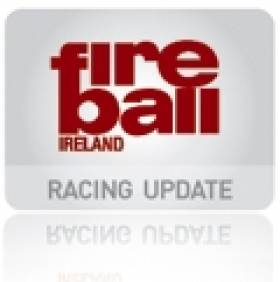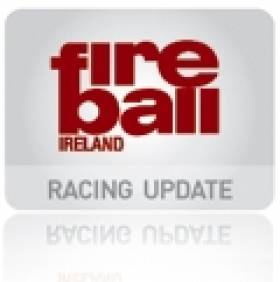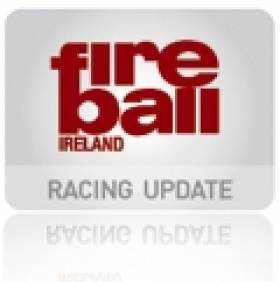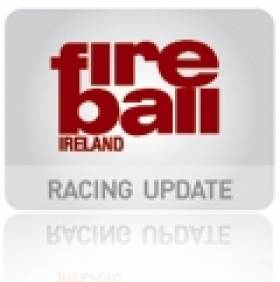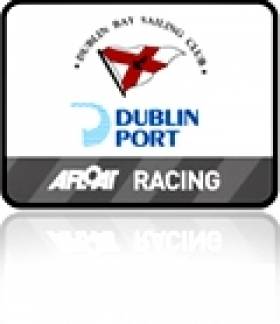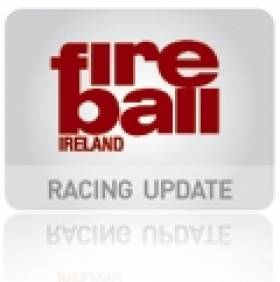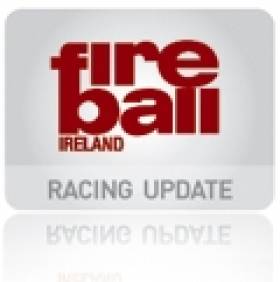Displaying items by tag: Fireball
20 Confirmed for Fireball Leinsters in Howth
The Fireball Leinster Championship at Howth YC this weekend has 20 confirmed entries to date, including the current National Champions and pre-event favourites Noel Butler and Shane McCarthy from Dun Laoghaire Motor Yacht Club. The southside pairing has already won the Open Championship at Killaloe and the Ulsters at East Down. Other leading contenders include Simon McGrotty of Skerries, Neil Colin of DMYC and Kenneth Rumball of the Royal St.George.
Traditional northern hospitality was strongly in evidence when the Irish Fireball fleet made their debut appearance at Strangford Lough’s East Down Yacht Club.
Situated a short distance round the coastline from Killyleagh, EDYC played host to 16 Fireballs, a similar number of Wayfarers, sailing their National Championships, and a group of Drascombe Luggers who were having a cruise in company.
For the Fireball Class the turnout was disappointing! We had hoped that a number of Scottish boats would make the regatta but they pulled out late Friday and a number of other entries also had to pull out at short notice. For some unknown reason the Ulsters don’t enjoy the same support as the other events which is very surprising because we always enjoy a superb hospitality when we go north. As with last year in Lough Neagh, the club put on live music on the Saturday night, which combined with an excellent barbecue and home made desserts meant that there was every incentive to stay on at the club for the evening.
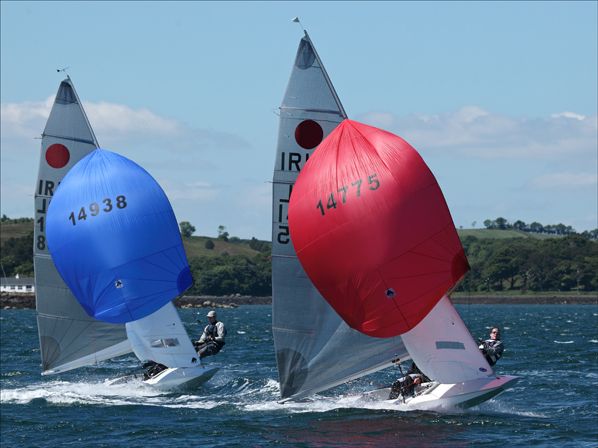
Pic: Vivienne Beck
On the water, the wind and individual performances were of the Jekyll and Hyde variety, with certain, almost predictable exceptions. One combination got back to winning ways; another combination found that sailing in more tangible breeze presented a different challenge to the last Fireball outing when light winds dominated the entire weekend. One recent World Championship entrant had, by their standards a nightmare weekend and had to chalk the regatta down to a character-building exercise. Local Fireballers, Brian O’Neill, with Owen Sinnett crewing and father and daughter John & Karen Orr must have enjoyed the company of the visitors and they both had a superb 5th race when the former led the race for a period followed closely by his clubmates. They slipped down the order but managed to post a single digit result. For those who had gone to Barbados for the aforementioned Worlds, this was a first opportunity to wet their boats since they emerged from the UK-bound container last Wednesday morning (16th).
Four races were sailed on Saturday and the wins were shared equally by Noel Butler/Shane McCarthy and Damien Bracken/Brian O’Hara. For the Clontarf-burgeed combination, hearing a winning gun is something they have been missing for a while so they were in very good form at the close of the racing as their last race win saw them top the leaderboard. Butler/McCarthy had their work cut out for them in all the races and indeed opened with a fourth in Race 1. However, order was restored when their count of the next three races was 1-1-2, though they didn’t lead these from the front.
Louis Smyth/Cormac Bradley had a good day on the water as well when a 5-9-3-3 sequence saw them in fourth place overall, three points adrift of Simon McGrotty/Ruairi Grimes of Skerries who had a 2-2-4-6 score.
Race Officer Roy Edwards set four races on Saturday, sailed in good trapezing breezes using a trapezoid course to keep the Fireballs and Wayfarers apart. Exciting spinnaker reaches and long downwind legs were indicative of the racing on Saturday, sailed in sunny but slightly cool conditions.
Louise McKenna/Hermine O’Keefe, who had finished on the podium in Killaloe and have been doing well in DBSC with new-found boatspeed, found these conditions less to their liking – in terms of results anyway, posting results outside the top ten.
Five boats made up the silver fleet and here Stephen Oram and new crew Joan Mulloy put their stamp on the fleet on Saturday and had a comfortable margin over the rest.
By the time the fleet got ashore they knew that they had had a challenging day on the water – not excessive, but enough to know the sinews had been stretched a bit!
Sunday saw a complete change in the weather! The sun was still out, but the wind had disappeared! And so the early start was postponed while the fleet waited for the breeze to fill in. The Drascombe Luggers disappeared northwards under motor! Out of Killyleagh, six or seven Formula Ones enjoyed an early race before they too had to wait for the wind Gods!
Race 5 was sailed under light conditions with none of the crews getting out on trapeze, or if they did, it was only momentarily. Butler/McCarthy banged in another first, followed home by John Chambers/Francis Rowan who had been slightly off the pace the day before. Chambers, a debutant in Fireballs was enormously enthusiastic about the racing of the previous day, so must have been delighted with a second place. McKenna/O’Keefe started the Jekyll & Hyde comparison with a 3rd, while Neil Colin/Margaret Casey scored a 4th to start moving up the rankings overall. Bracken/O’Hara contributed to the Jekyll & Hyde syndrome by posting a 14th, while Owen Laverty & Ed Butler posted the first of two DNFs. Smyth/Bradley also suffered with the first of two tenth places.
Race 6 saw an improvement in the conditions but the wind still wasn’t as healthy as the day before. McGrotty/Grimes took the race by the scruff of the neck to win, leading all the way round, with Chambers/Rowan 2nd and Colin/Casey 3rd. Bracken/O’Hara pulled off a Houdini act to recover to 6th and save their position on the podium. Possibly because they knew they were safe, Butler/McCarthy posted their worst result of the weekend, a 5th, which was discarded, to win the event overall. McGrotty/Grimes’ last race win saw them finish behind Bracken/O’Hara overall and 1pt ahead of Chambers/Rowan who took 4th.
In the Silver fleet, Oram/Mulloy also had a good Sunday seeing their lead stretch to 7pts after discard and a 8th place overall. McKenna/O’Keefe finished second in the Silver fleet, with the home clubs’ Brian O’Neill and Owen Sinnett in third.
Challenging conditions were married with superb hospitality from EDYC and at the prize-giving Gordon Jess was commended for his work in the planning of this three-class event weekend. EDYC have maintained the tradition of northern hospitality enjoyed by the Fireball Class!
|
Sail No |
Helm |
Crew |
Race 1 |
Race 2 |
Race 3 |
Race 4 |
Race 5 |
Race 6 |
Nt Pts |
Pos |
|
Gold Fleet |
||||||||||
|
14894 |
Butler |
McCarthy |
4 |
1 |
1 |
2 |
1 |
5 |
9 |
1 |
|
14904 |
Bracken |
O’Hara |
1 |
3 |
2 |
1 |
14 |
6 |
13 |
2 |
|
14981 |
McGrotty |
Grimes |
2 |
2 |
4 |
6 |
9 |
1 |
15 |
3 |
|
Silver Fleet |
||||||||||
|
14854 |
Oram |
Mulloy |
10 |
7 |
12 |
14 |
6 |
8 |
43 |
8 |
|
14691 |
McKenna |
O’Keefe |
13 |
13 |
16 |
12 |
3 |
9 |
50 |
12 |
|
14595 |
O’Neill |
Sinnett |
12 |
16 |
13 |
11 |
7 |
11 |
54 |
14 |
Butler and McCarthy Lead Fireball Sailors to East Down Venue
Noel Butler and Shane McCarthy lead the Irish Fireball dinghy sailing rankings after success in the opening event of the season in Killaloe in the last weekend of May. The next event on the regatta circuit is the Ulster championships, hosted by East Down Yacht Club on Strangford Lough this weekend. The leading crew are pictured wirth their prizes after the Killaloe event with club commodore Jim Ryan (Killaloe) centre
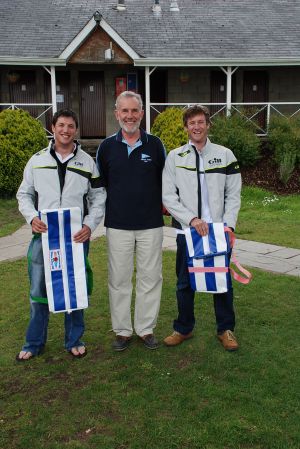
Butler & McCarthy Take Season Opener
The Irish Fireball fleet, minus those boats in transit from Barbados, descended on Killaloe at the southern end of Lough Derg for the season-opening regatta, the Open Sailing Championships. Hosted by the Killaloe Sailing Club for the first time in quite a few years, but based at the University of Limerick’s Activity Centre, the event attracted an excellent entry of 25 boats considering there were some significant absentees.
A large percentage of the fleet was home-based and the racing on the water was soon to validate the training sessions that Neil Colin and others have conducted both in Killaloe and Dun Laoghaire, when participants in those sessions featured in excellent individual race performances and overall positions.
Race Officer Liam Moloney and his team on the water had a very challenging weekend as the winds were light and on Sunday in particular, variable. Having said that, seven races were sailed when Race 3 was ordered to be re-sailed after a protest! The lightness of the breeze presented the fleet with the need for heightened awareness of wind on the water and meant that decisions on which way to go were much more significant than when the wind is more vigorous!
The new combination of Shane McCarthy & Noel Butler provided the element of consistency that these conditions demand to win by a comfortable margin of 4 points, but in terms of individual race wins they only took half the races. However, a discard of a 3rd shows how well these two sailed in the trying conditions.
The other race wins were shared by Neil Colin & Margaret Casey, who finished second overall, Louis McKenna & Hermine O’Keeffe, who took third and Simon McGrotty & Ruairi Grimer who finished fourth overall. Colin/Casey had a very good series after discarding a tenth, while McKenna/O’Keeffe surprised everyone with the consistency of their boatspeed all weekend allowing them to win one race and add three other top four positions to their points tally.
Jim Ryan & David Tanner from the host club also hit a purple patch, scoring a 2nd, a 5th and a 6th to be the first local boat in 5th overall. Jon Evans & Aidan Caulfield led the fifth race of the regatta and only just lost out on the finish line to Butler/McCarthy. Other excellent race performances came from Marie Barry who counted three top ten finishes, Susie Coot & Christope LeScornet, in the Silver fleet who also scored three top ten finishes, Mary Chambers & Brenda McGuire who got a 9th in the last race and Derval O’Carrol & Siobhan Hayes who scored an eighth in Race 2. All these combinations were attendees at recent training sessions and this weekend saw the fruits of that training.
Saturday evening was spent in Crotty’s in Killaloe where the fleet enjoyed superb hospitality and lots of craic having pre-booked their meals for the evening at registration that morning. A traditional three-piece band played in the background keeping us distracted while with one eye on the TV screen we watched Ireland’s entry to Eurovision drop further and further down the scoreboard.
Having sailed four races on the Saturday, we appeared to be set up for an early finish on the Sunday when only two races were required to make up the series. However, with Race 3 thrown out on a technicality, three races were sailed on Sunday, before our guillotine on start times kicked in and a full six race series was completed.
The prevailing conditions meant that races were short and they may not have been to everyone’s taste, but in truth the race team did everything they could to get a regatta in and they couldn’t be faulted for effort.
The regatta also saw the competitive debut of our newest Fireball, 15018, a home built wide-bow in wood by Martin O’Toole. As the results below show, Martin and his crew Shane scored a 5th in one race.
Prizes for the event were provided by McWilliam’s Sailmakers and due thanks were offered to all those who had sponsored and contributed to the hosting of the event.
Sail No. Helm Crew Club 1 2 3 4 5 6 Total
Gold
14894 Noel Butler Shane McCarthy DMYC 1 3 2 1 3 1 8
14775 Neil Colin Margaret Casey DMYC 2 1 3 10 4 2 12
14691 Louis McKenna Hermine O’Keeffe RStGYC 8 6 4 3 1 4 18
Silver
14176 Susie Coote Christope LeScornet KSC 15 7 10 15.5 7 13 52
14416 Mary Chambers Brenda McGuire DMYC 17 15 12 22 17 9 70
15018 Martin O’Toole Shane O’Toole SSC
Colin and Casey Wins Fireball DBSC Race
Neil Colin's appropriately named Elevation went straight to the top of the local Dublin Bay Sailing Club Fireball dinghy fleet in last night's race in Scotsman's Bay. Racing in moderate westerly conditions and an ebb tide, Marie Barry's Reality Check was second and Incubus (S Oram) third. In the IDRA 14 dinghy class Frank Hamilton's Dunmoanin continues his winning run. Full sailing results click read more.
DUBLIN PORT Dublin Bay Sailing Club Results for 18 MAY 2010
CRUISERS 1 - 1. Jalapeno (Dermod Baker et al), 2. Lula Belle (Liam Coyne)
CRUISERS 3 - 1. Grasshopper 2 (K & J Glynn), 2. Chouskikou (R.Sheehan/R.Hickey), 3. Papytoo (M.Walsh/F.Guilfoyle)
CRUISERS 4 - 1. Maranda (Myles Kelly), 2. Aslana (J.Martin/B.Mulkeen), 3. Ghrazel (Charles Pearson)
FIREBALL - 1. Elevation (N.Colin/M.Casey), 2. Reality Check (Marie Barry), 3. Incubus (S Oram)
GLEN - 1. Glencorel (B.Waldock/K.Malcolm)
IDRA 14 FOOT - 1. Dunmoanin (Frank Hamilton), 2. Dart (Pierre Long), 3. Doody (J.Fitzgerald/J.Byrne)
MERMAID - 1. Tiller Girl (J.O'Rourke), 2. Lively Lady (G O'Neill & M Hanney), 3. Kim (D Cassidy)
PY CLASS - 1. Joan Flanagan (Laser), 2. Richard Tate (Laser), 3. David Dwyer (Laser)
RUFFIAN 23 - 1. Alias (D.Meeke/M.McCarthy), 2. Cresendo (L Balfe), 3. Diane ll (Bruce Carswell)
SIGMA 33 - 1. White Mischief (Timothy Goodbody), 2. Pippa lV (G.Kinsman/K.Blake/M.O'Brien)
SQUIB - 1. Little Demon (Marie Dee), 2. Periguin (N.Coakley/J.Redahan)
Fireball title decided one day out
Among the Irish sailing entries, Neil Spain & Francis Rowan are the leading boat in 21st overall with Noel Butler & Seamus Moore in 26th. These two have kept most of their results in the twenties with each having a mid-teens result and a 30th each as well.
In 35th overall, Messrs Laverty & Butler have scored results mostly in the thirties but with one result in the twenties (27th) and two in the forties. Next up is Smyth/Bradley in 46th with a high of a 31st and a low of a DNF. Their results are consistently in the forties. Frank Miller & Marguerite O'Rourke have not had a good series by their standards and lie in 49th with the last Irish boat Hannah Showell & Martina Michels in 60th.
Other well known combinations are as follows; Derian & Andy Scott (18th), Tim Rush & Russ Clark (9th), Vince Horey/ Sam Brearey (11th) and Heather McFarlane & Chris Payne (17th).
Two races tomorrow (Fri) conclude the series but Howarth/Townend don't look as though they need to sail them both. Prize-giving is scheduled for tomorrow evening.
It has been a physically challenging series even on those days when the wind eased. The fleet has been launching at 11:45ish for a 12:30 start and getting ashore at around 16:30. Most evenings have seen the club environs empty earlyish. Burning the midnight oil in a social context has been the exception rather than the rule!!
Butler and Moore Best of Irish Fireballs in Barbados
Fireball International Week, the warm up to next weeks world championships, concluded in Barbados yesterday. Dublin's Noel Butler and Seamus Moore were the best of the Irish with two 14s leaving them in 16th overall. Neil Spain and Franis Rowan finishe just outside the top 20 in 21st. Owen Laverty and Hugh Butler also had a good days sailing with two scores in the twenties. This allowed them to crack a top 30 finish in 29th. They were followed in the overal ranking by Smyth/Bradley in 37th, and Miller/O'Rourke in 56th. The 61 boat fleet was led home by a Brit 1-2-3 with Howarth/Townsend winning both races toiday to post a warning to all those with designs on their Worlds title. Second were Dave Edwards and Simon Potts, followed by Kevin Hope/Russell Thorne. The winners had a 2pt margin on second.
More on the forum thread here.
Irish Sailing Classes and Associations
Spoiled for Choice
There’s no shortage of one-design classes from which to choose and each gives its enthusiasts great competition, fun and camaraderie, writes Graham Smith in this review of the classes. A profile of each active class in Ireland is supplied below; just click on the title link (in bold) or the Class Association link to go directly to the information.
One-design racing is where it all starts. It is, after all, where all the top sailors earned their stripes, battling away for line honours without a thought for a handicapper’s calculator wiping away a hard-fought victory!
Indeed, you could count on less than one hand the number of top Irish sailors who didn’t cut their teeth in a one-design dinghy! Just think of Cudmore, Barrington, Watson, Wilkins, Hennessy and Dix to name a few and you realise that they honed their skills in everything from Enterprises to Lasers and a lot in between.
At present count, there are a little over 30 one-design classes in Ireland, split almost evenly between dinghies and keelboats, a statistic which might raise a few eyebrows. They range from the long-established Mermaids, IDRA14s and Dragons to the newer additions like Fevas, Topaz and RS Elite. They all fill a particular need and give their owners and crews considerable enjoyment.
Many have attracted their World or European Championships to Irish waters over the years and while 2009 is notable for a lack of such events here, the following year will see the Etchells Worlds at Howth and perhaps a few other international regattas too.
In addition to the review, we asked each class to complete a questionnaire giving details of their fleet numbers, whether they were on a growth pattern or holding their own, so we could highlight those ‘on the up’ and those remaining static in terms of numbers. The older traditional designs, as you might imagine, fall into the latter category, although that’s not a negative!
CLASS REVIEW The State of the Classes – League Table (as at February 2009)
S = Static; U = Up/growing
275 Optimist U
200+ Laser S
189 Mermaid S
160 Flying Fifteen S
130 RS Feva U
115 Shannon One Design U
100+ Mirror S
100+ Topper U
99 Topaz U
94 Laser SB3 U
87 GP14 U
85 Squib S
70 Fireball S
70 Ruffian S
60 J24 S
60 Shipman S
52 Dragon S
50 RS400/200 S
50 420 U
43 Multihulls U
42 Dragon S
40 Water Wags U
40 Wayfarer S
34 IDRA14 U
33 Puppeteer U
28 Etchells S
27 E-Boat U
26 Glen S
25 Enterprise S
18 Sigma 33 S
18 Howth 17 U
13 RS Elite U


























